A Leg Takedown & Submission
By Christoper Caile
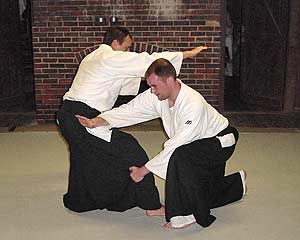
Methods of diving under an opponent’s arms, to grab an ankle or
leg and then using body leverage to take the opponent down (sometimes
referred to as “shooting”) are found in almost every branch
of the martial arts.
They are the staples of wrestling, Brazilian Jujutsu, the UFC and other
variations of the almost “anything goes” full contact competitions.
And if you are in a bar fight don’t be surprised if your opponent
resorts to wrestling and some form of attempted low leg takedown too.
Low (shooting) takedowns are also found in many Kung Fu arts, such as
praying mantis and shuai chiao. In my own Seido Karate there are also
several variations practiced in our self-defense exercises.
This type of takedown is effective for several reasons. It can be a surprising
move against you, especially if you are startled by an initial technique
to the face and you react my leaning back away from the technique. It
is also an effective move against an opponent who attacks with a flurry
of fast punches. Many stand up fighters just don’t see it coming
and are not versed to defending against it.
Your experience can also work against you. Several years ago when training
in Buffalo, NY with several UFC competitors and other fighters I was surprised
how my former Kyokushin training worked against me. I quickly learned
that lifting a leg to block a low shin kick to my leg also set me up for
a quick shoot and takedown. I had to modify my reactions to take into
account this type of takedown. Instead of lifting a leg to block low leg
kicks I learned how to also shift and move my body to avoid them.
Takedown reflect an old strategy – of faking east while attacking
west. Of course it is twisted 90 degrees here -- faking high and striking
low.
Many karate kata illustrate this principle, such as in Seienchin and
Gojushiho (koryogojushiho) where a high back fist downward strike to an
opponent’s face masks a simultaneous stomp to an opponent’s
foot. A judo practitioner might use this same principle in self-defense
by executing a hand grab while simultaneously sweeping his opponent (the
sweep, however, is another permutation of this principle).
While variations are many, every martial artist should be aware of and
hopefully trained one or more of them.
Below Ryan Lynch Sensei of Roy Suenaka’s Wadokai Aikido (Raleigh,
NC.), assisted by Brad Jones, illustrate one method of takedown. This
is followed up by a leg submission. While this is not an aikido technique
per se, it does reflect peripheral training.
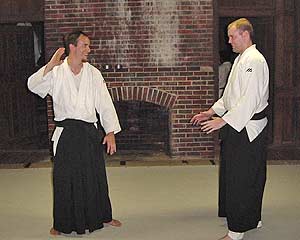 |
The opponent at left prepares to strike.
The type of strike is not important. The defender could also just
fake a high technique or punch of his own, then perform the takedown.
|
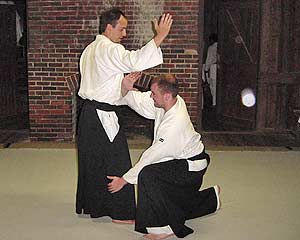 |
As the opponent steps forward, the defender drops down
and inward (left leg forward) onto one knee under the strike. His
body erect, the defender’s left hand goes behind the ankle of
the attacker’s advancing leg, while his right forearm (bent
at 90 degrees) hits into the attacker at waist level.
|
 |
The defender uses his weight and forward momentum
to lever (pushing with his right forearm and pulling with his left
hand) the attacker backward. Notice that while his lower body is
still centered, his upper torso follows into the technique.
|
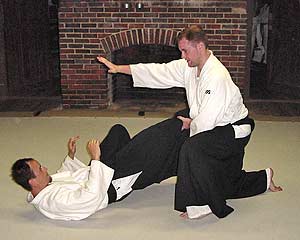 |
The attacker is propelled backward onto the ground.
Notice that the defender still has hold of the opponent’s
right leg with his left hand.
|
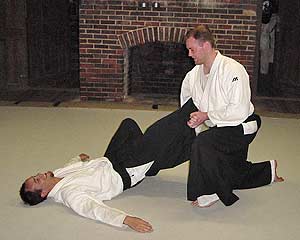 |
The defender’s right arm then moves down,
over and then under the opponent’s extended leg, the right
hand (palm to palm) ending on top of his left hand (thus encircling
the leg and pressing up into the Achilles Tendon (several inches
above the ankle) with the upper edge of the forearm).
|
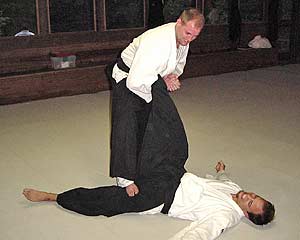 |
Seen from the opposite side -- the defender rises
and while applying upper pressure against the Achilles Tendon the
right foot moves forward with his body (as he steps up) to simultaneously
press down (edge of his right foot) into the inside of the attacker’s
left upper thigh. As this is executed the defender lifts with his
back to put extra pressure on the leg – a painful submission.
|
|
A close-up of the defender’s hand position
for the submission.
|
About The Author:
Christopher Caile is founder and Editor of FightingArts.com
About the Demonstrator of the Technique:
Ryan Lynch began training in Wadokai Aikido in 1994 and is ranked nidan.
He has also trained Shorin-ryu karate beginning at age 4 under his parants
and is ranked nidan in that as well.
|